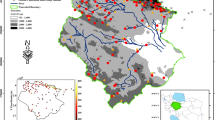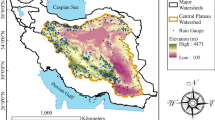Abstract
Several climatic variables like precipitation, temperature, fog, dew, humidity, and wind significantly impact agricultural production. While formulating policies for agriculture and other industrial sectors, precise knowledge regarding climatic variables is essential and helpful. The Bureau of Meteorology (BOM) monitored various climatic variables at more than 226 meteorological stations in New South Wales (NSW), Australia. However, the placement of these monitoring stations was not systematic. As a result, predictions for unobserved sites turn out to be erroneous. Inadequate or poorly placed meteorological stations can lead to inaccurate weather forecasts, make it difficult to fully understand local and regional weather patterns, and, lastly, make it impossible to identify the early warnings for severe weather events like hurricanes, tornadoes, and flash floods. Therefore, the study aims to optimize and suggest a monitoring network to minimize the prediction error of these climatic variables. The optimized monitoring network can be found by optimally adding new meteorological monitoring stations or withdrawing existing ones while still ensuring the reliability of weather data. In this study, the meteorological monitoring network of NSW, Australia was optimized using two stochastic search algorithms: Spatial Simulated Annealing (SSA) and Genetic Algorithms (GA). The Average Kriging Variance (AKV) is considered an accuracy measure for SSA and GA. Ordinary kriging (OK) and Universal Kriging (UK), two popular prediction methods, are used using covariation modeled by the Matheron variogram model. The results reveal that the time consumption for SSA and GA are relatively similar, but the SSA utilizing the UK gives a lower AKV than GA. The optimized meteorological monitoring will be useful for ensuring accurate weather forecasts, providing early warnings of severe weather events, and enabling scientific research to understand and mitigate the effects of climate change. Furthermore, this novel optimization strategy will not only be helpful for the government of Australia but will significantly improve prediction accuracy, providing more reliable information for various weather-related activities, such as agriculture, construction, and emergency management.









Similar content being viewed by others
Data Availability
The data set is with corresponding author, will be provided upon request.
Change history
12 June 2023
A Correction to this paper has been published: https://doi.org/10.1007/s11269-023-03547-4
References
Australia NM (2023, February 2, 2023) Gundagai flood. Retrieved from https://www.nma.gov.au/defining-moments/resources/gundagai-flood-1852
Baume O, Gebhardt A, Gebhardt C, Heuvelink GB, Pilz J (2011) Network optimization algorithms and scenarios in the context of automatic mapping. Comput Geosci 37(3):289–294
Brus DJ, Heuvelink GB (2007) Optimization of sample patterns for universal kriging of environmental variables. Geoderma 138(1–2):86–95
Daigle A, Caudron A, Vigier L, Pella H (2017) Optimization methodology for a river temperature monitoring network for the characterization of fish thermal habitat. Hydrol Sci J 62(3):483–497
Delmelle EM, Goovaerts P (2009) Second-phase sampling designs for non-stationary spatial variables. Geoderma 153(1–2):205–216
Diggle PJ, Ribeiro PJ, Geostatistics MB (2007) Springer series in statistics. Springer, Berlin
Eslamian S, Parvizi S, Ostad-Ali-Askari K, Talebmorad H (2018) Water. In: Bobrowsky P, Marker B (eds) Encyclopedia of Engineering Geology. Springer International Publishing, Cham, pp 1–5
Gallagher K, Sambridge M (1994) Genetic algorithms: a powerful tool for large-scale nonlinear optimization problems. Comput Geosci 20(7–8):1229–1236
Ge Y, Wang J, Heuvelink GB, Jin R, Li X, Wang J (2015) Sampling design optimization of a wireless sensor network for monitoring ecohydrological processes in the Babao River basin, China. Int J Geogr Inf Sci 29(1):92–110
Gebhardt C (2003) Bayesian methods for Geostatistical Design. University of Klagenfurt
Guedes LPC, RIBEIRO JR PJ, De Stefano Piedade S, Uribe-Opazo MA (2011) Optimization of spatial sample configurations using hybrid genetic algorithm and simulated annealing. Chil J Stat (ChJS) 2(2):39–50
Haas TC (1992) Redesigning continental-scale monitoring networks. Atmospheric Environ Part Gen Top 26(18):3323–3333
Heuvelink GB, Jiang Z, De Bruin S, Twenhöfel CJ (2010) Optimization of mobile radioactivity monitoring networks. Int J Geogr Inf Sci 24(3):365–382
Isaaks E, Srivastava R (2001) An introduction to applied geostatistics. 1989. J Glob Optim 23:345–383
Khan S, Hussain I, Rahman A (2021) Identification of homogeneous rainfall regions in New South Wales, Australia. Tellus A: Dyn Meteorol Oceanogr 73(1):1–11. https://doi.org/10.1080/16000870.2021.1907979
Kirkpatrick S, Gelatt CD, Vecchi MP (1983) Optimization by simulated annealing. Science 220(4598):671–680
Matheron G (1963) Principles of geostatistics. Econ Geol 58(8):1246–1266
Matheron G (1989) The internal consistency of models in geostatistics. Paper presented at the Geostatistics: Proceedings of the Third International Geostatistics Congress September 5–9, 1988, Avignon, France
Melles S, Heuvelink GB, Twenhöfel CJ, van Dijk A, Hiemstra PH, Baume O, Stöhlker U (2011) Optimizing the spatial pattern of networks for monitoring radioactive releases. Computers Geosci 37(3):280–288
Melo C, Santacruz A, Melo O, Santacruz MA (2015) Package ‘geospt’. criterio, 105, 9
Meteorology Bo (2020, May 16, 2014). Stormy Weather. Retrieved from http://www.bom.gov.au/nsw/sevwx/facts/stormy-weather.pdf
Metropolis N, Rosenbluth AW, Rosenbluth MN, Teller AH, Teller E (1953) Equation of state calculations by fast computing machines. J Chem Phys 21(6):1087–1092
Mohammadinezhad A, Jalili M (2013) Optimization of echo state networks for drought prediction based on remote sensing data. Paper presented at the 2013 IEEE 8th Conference on Industrial Electronics and Applications (ICIEA)
Omer T, Hassan MU, Hussain I, Ilyas M, Hashmi SGMD, Khan YA (2022) Optimization of monitoring network to the rainfall distribution by using stochastic search algorithms: lesson from Pakistan. Tellus A: Dyn Meteorol Oceanogr 74(2022):333–345. https://doi.org/10.16993/tellusa.247
Ostad-Ali-Askari K, Kharazi G, Shayannejad H, Zareian MJ (2020) Effect of climate change on precipitation patterns in an arid region using GCM models: case study of Isfahan-Borkhar Plain. Nat Hazards Rev 21(2):04020006
Pardo-Igúzquiza E (1998) Optimal selection of number and location of rainfall gauges for areal rainfall estimation using geostatistics and simulated annealing. J Hydrol 210(1–4):206–220
Pearl J (1984) Intelligent search strategies for computer problem solving: Judea Pearl. Addison-Wesley Publishing, 382 pp
Pebesma E, Skoien JO, Hristopulos HK, Melles SJ, Spiliopoulos G, Skoien MJO (2018) Package ‘intamap’. https://cran.microsoft.com/snapshot/2020-04-20/web/packages/intamap/intamap.pdf
Pebesma EJ (2004) Multivariable geostatistics in S: the gstat package. Comput Geosci 30(7):683–691
Pincus M (1970) Letter to the editor—a Monte Carlo method for the approximate solution of certain types of constrained optimization problems. Oper Res 18(6):1225–1228
Ribeiro PJ Jr, Diggle PJ, Ribeiro Jr MPJ, Suggests M (2007) The geoR package. R news 1(2):14–18
Ride WDL, Roe M (2020, June 24, 2020). Australia. Retrieved from https://www.britannica.com/place/Australia
Santacruz A, Rubiano Y, Melo C (2014) Evolutionary optimization of spatial sampling networks designed for the monitoring of Soil Organic Carbon. Soil Carbon. Springer, pp 77–84
Sastry K, Goldberg D, Kendall G (2005) Genetic algorithms search methodologies. Springer, Berlin, pp 97–125
Sohrabi B (2006) A comparison between genetic algorithm and simulated annealing performance in preventive part replacement, Management Knowledge Spring, 2006, No. 72, 120–112
Soroush F, Abedini MJ (2019) Optimal selection of number and location of pressure sensors in water distribution systems using geostatistical tools coupled with genetic algorithm. J Hydroinformatics 21(6):1030–1047
Van Groenigen JW, Siderius W, Stein A (1999) Constrained optimisation of soil sampling for minimisation of the kriging variance. Geoderma 87(3–4):239–259
Vrugt JA, Robinson BA, Hyman JM (2008) Self-adaptive multimethod search for global optimization in real-parameter spaces. IEEE Trans Evol Comput 13(2):243–259
Wikipedia (2023, February 2, 2023). Floods in Australia. Retrieved from https://en.wikipedia.org/wiki/Floods_in_Australia
Zhu Z, Stein ML (2006) Spatial sampling design for prediction with estimated parameters. J Agric Biol Environ Stat 11(1):24
Acknowledgements
The authors extend their appreciation to the Deanship of Scientific Research at King Khalid University for funding this work through the Large Groups Research Project under grant number (RGP.2/23/44).
Author information
Authors and Affiliations
Corresponding author
Ethics declarations
The authors declare that they have no known competing financial interests or personal relationships that could have influenced the work reported in this paper.
Consent for Publication
The authors authorize the publication of this manuscript.
Consent to Participate
The authors declare that this research would be used only for scientific research and would not pass on to third parties.
Conflict of Interest
The authors declare that they have no conflict of interest.
Additional information
Publisher’s Note
Springer Nature remains neutral with regard to jurisdictional claims in published maps and institutional affiliations.
The original online version of this article was revised: In this article, the second affiliation details of Mohammed M. A. Almazah was removed and the Acknowledgements statement should be “The authors extend Their appreciation to the Deanship of Scientific Research at King Khalid University for funding this work through the Large Groups Research Project under grant number (RGP.2/23/44)..
Rights and permissions
Springer Nature or its licensor (e.g. a society or other partner) holds exclusive rights to this article under a publishing agreement with the author(s) or other rightsholder(s); author self-archiving of the accepted manuscript version of this article is solely governed by the terms of such publishing agreement and applicable law.
About this article
Cite this article
Khan, S., Almazah, M.M.A., Rahman, A. et al. Optimization of Meteorological Monitoring Network of New South Wales, Australia. Water Resour Manage 37, 3395–3419 (2023). https://doi.org/10.1007/s11269-023-03507-y
Received:
Accepted:
Published:
Issue Date:
DOI: https://doi.org/10.1007/s11269-023-03507-y




